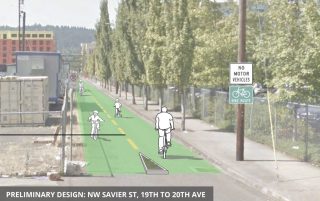
When a seven-page memo detailing changes to the Northwest in Motion plan was released late last month by the Portland Bureau of Transportation, many advocates were animated in their disapproval.
“All the ways in which Northwest in Motion is being watered down is so incredibly depressing,” NextPortland blogger and transportation reform activist Iain MacKenzie shared on Twitter.
NWIM is the city’s plan to dramatically increase biking, walking and transit use in the Northwest District. When we shared the draft plan back in November it came with an expectation that the projects would double bike use. In the past two years of planning, PBOT has identified a list of projects that are truly unprecedented for this part of town. From five new neighborhood greenways and a district-wide 20 mph speed limit zone, to carfree streets and 12 new diverters that are estimated to take 12,000 cars off the road every day.
So when the “Revisions Memo” came out with significant changes to some of the more exciting elements of the plan, it’s easy to see why some people were a bit crestfallen. We’ve seen this movie before: PBOT teases bold projects that get us dreaming of a new future — then they water them down or give up on them completely when pushback arises.
Here are some of the changes that have raised eyebrows:
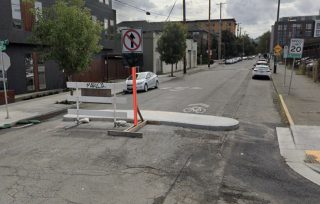
Diverter at NW 20th and Raleigh: PBOT installed a full diverter in the southern leg of the intersection as part of their 20th Ave LID project.
Now PBOT says:
“Since installation, we have heard significant concerns from residents, businesses, and property owners about how the design of the diverter negatively impacts neighborhood circulation and access to on-street parking. We have also heard concerns from PBOT staff and developers in the Slabtown area that this full diverter design is inconsistent with the Conway Master Plan and is also inconsistent with the other diverters we have proposed in Northwest in Motion, which are usually semi-diverters that only impact one direction of traffic at a time. PBOT agrees that the design of this diverter is problematic and that it should be modified in the near future to better match the overall diversion strategy. We plan to make 20th Ave one-way northbound for traffic from Quimby to Raleigh, with a contraflow bike lane, similar to the design on 20th Ave from Everett to Flanders. Just like our approach to diversion on other neighborhood greenways, we will commit to monitoring the effectiveness of the diverter and if northbound volumes increase on 20th Ave in the future to an unacceptable level we will re-engage the public around adding another diverter further south on 20th Ave, for example near Lovejoy or Northrup.”
NW Overton Neighborhood Greenway: Proposal was a striped bike lane on the south side made possible by removing all auto parking from 9th to 11th.
Now PBOT says:
“We heard concerns from small businesses and residents along NW Overton St from 9th to 11th that the amount of on-street parking removal, including all parking on the south side, would have a negative impact on the viability of the businesses along the street. In response, PBOT staff met with concerned business owners and residents and explored various options and alternatives in more detail. A major point of concern was that our proposal only left Overton easily accessible from the west, but all the remaining parking would be in the opposite direction. This seemed to be a legitimate concern as it would make circulation difficult and may dissuade people from visiting and parking in the area.
The project team took a look at options and realized that on-street parking could be restored on the south side of the street without compromising the neighborhood greenway connection…. we believe that bikes will have adequate time to travel along Overton eastbound without being passed or closely followed by motor vehicles [Note: It will now be a shared-street environment with no dedicated bike space.]. The revised proposal will still have a diverter for the westbound direction at 9th Ave, but to ensure it can be easily used as Major Emergency Response Street we will revise the graphic to show a striped bike lane with no concrete island.”
NW Savier between 19th and 20th: One of the more exciting proposals of the plan was a carfree street at this location.
Now PBOT says:
“Revise NW Savier St proposal from 19th to 20th to allow two-way motor vehicle traffic while still calming traffic and ensuring a low-stress environment. We received feedback from property owners and developers in the rapidly-developing Slabtown area, as well as from PBOT Development Review staff, that the proposed changes to NW Savier St were inconsistent with the adopted Conway Master Plan and would unduly hinder development in the area… The project team is comfortable removing the proposed car-free street, because we can monitor traffic volumes and could propose diverters further east or west of the Conway area in the future as needed…”
Advertisement
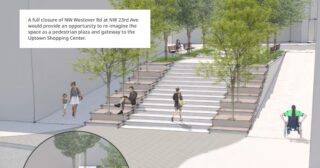
NW 23rd and Westover: Initial proposal was for a carfree plaza on this block north of 23rd.
Now PBOT says:
“We received a great deal of feedback expressing concerns about the proposed closure of NW Westover Rd to traffic as it approaches NW 23rd Ave. Feedback included concerns about potential difficulty programming a plaza space in that context due to the steep slope and lack of ground-floor activity, concerns about loss of on-street parking in a high-demand area, and the impact of traffic that would be directed to Everett and 23rd. Overall, there was a strong theme in the feedback that people felt Westover should remain open to traffic to preserve access and circulation in the constrained area around the Uptown Shopping Center.”
NW Everett Bike Lane: Not part of NWIM, but PBOT gets constant criticism about this bike lane that was installed in 2014 (this coverage in NW Examiner probably hasn’t helped).
Now PBOT says:
“We have also heard continuing frustration with the design of NW Everett St… The main concern seems to be a perception that the space is inefficiently used because bike volumes are low while traffic queues in the single remaining motor vehicle lane… PBOT has justified the project based on the need for basic bike network connectivity… this justification may not continue to make sense once the Flanders Bridge is constructed over I-405, as people biking will then have a low-stress and high-quality connection to and from the Pearl District… We continue to think that any decision to convert the bike lane to other uses should wait until after we can measure what happens to bike travel after the Flanders Bridge is constructed.”
Advertisement
So, what do advocates think of these changes? And how does PBOT justify them?
“Even with the negative changes, there is still a lot for advocates to celebrate in this plan.”
— Reza Farhoodi
Reza Farhoodi is planning and transportation committee co-chair for the Pearl District Neighborhood Association and is a member of the NWIM Community Advisory Group. “Even with the negative changes, there is still a lot for advocates to celebrate in this plan,” he wrote on the Bike Loud PDX email list last week. Farhoodi says the myriad diverters still in the plan will be “transformational” and bring northwest its first real, functioning neighborhood greenways. He also thinks it would be a big mistake for fellow activists to oppose the plan and jeopardize all the work that’s been put into the plan thus far. “I fear that framing this conversation around citywide parking policy (or why these are greenways and not protected bike lanes) will further fracture public opinion and risk setting back safe streets in NW for years to come.”
For their part, PBOT says the revisions are relatively minor when compared to everything else proposed in the plan. They say they’re obligated to address concerns about projects and their hands are tied due to the Conway Master Plan.
I talked to PBOT Public Information Officer Dylan Rivera and NWIM Project Manager Zef Wagner on the phone this morning. “That memo is about some really small refinements to a very large ambitious action plan that amounts to the biggest moves PBOT has made to create low-stress biking on a neighborhood and network scale in the city’s history,” Rivera said at the outset of our conversation.
“Some felt that the plan did not consider the needs of those who are automobile dependent and expressed concerns about the loss of parking.”
— from PBOT’s public feedback review summary
Wagner said PBOT is just doing their job. “When we get feedback from people… we’re obligated to look at the project and see if there’s a solution and find a way to deal with concerns without compromising the project.”
Asked about taking carfree NW Savier off the table, Wagner said the Conway Master Plan is a legally binding agreement with the City of Portland that takes precedence over other plans. PBOT can propose street designs and negotiate with Conway about them; but at the end of the day they must come to agreement. Wagner added that developers are “excited” about a special, low-car design of the street, but the carfree idea is a step too far. “They’re concerned because properties will be developed on both sides [possibly including a new hotel] and are feeling very hemmed in… they feel they need some access there.”
Advertisement
When it comes to the carfree block of NW Westover, Wagner said that came down to wanting to solve the traffic problems and not being married to a plaza that he says many people thought might flop. “It was a cool idea, but a lot of people just didn’t think it’d be successful as a public space.” It also came down to a realization from PBOT that auto traffic on Westover wasn’t the culprit to bus delays (the signal at 23rd and Burnside was), so there wasn’t an engineering reason to close the street to drivers.
“There just wasn’t a very compelling reason to remove the parking.”
— Zef Wagner, PBOT
On NW Overton, Wagner said after hearing from several business owners that they have customers who drive into appointments from the suburbs he and his team investigated the plans and felt they could add back the parking spaces without hurting the integrity of the biking environment. And since this is just a two-block stretch of the greenway (it’s mostly on Pettygrove), “There just wasn’t a very compelling reason to remove the parking.” Wagner also said having cars parked on the curb could actually make it a calmer street. “If we took all that parking way, the road would feel a lot wider.”
Rivera defended the decision, saying parking in northwest is already more expensive than any other place on the West Coast. He also said the proposed diverters will dramatically reduce driving trips and removing parking is, “Not what’s going to move the needle.” “One of our core goals of the projects wasn’t to reduce parking or auto access, our number one job is to make these other modes more attractive.”
Over the next few weeks PBOT will continue to tweak the proposals. Wagner will present the latest changes at the Bicycle Advisory Committee meeting next Tuesday (3/10) and a new recommended draft will be out by the end of this month. If all goes according to plan NWIM will be up for City Council adoption in April.
If you live, ride or work in northwest and want to learn more about these projects, Bike Loud will lead a NW in Motion Ride this Saturday (3/7), meeting at the Japanese American Historical Plaza in Waterfront Park at 3:00 pm.
— Jonathan Maus: (503) 706-8804, @jonathan_maus on Twitter and jonathan@bikeportland.org
— Get our headlines delivered to your inbox.
— Support this independent community media outlet with a one-time contribution or monthly subscription.



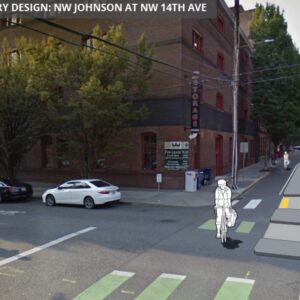

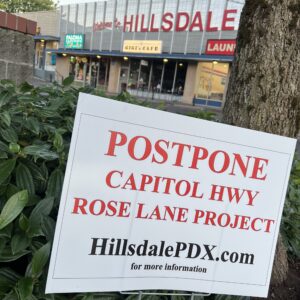
Totally lame.
“…access to on-street parking”. Disappointed, Portland. Now my city won’t remove our parking because even liberal Portland won’t remove theirs.
Yeah, my head exploded when I read that too.
Diverters, diverters everywhere.
I often fantasize about the connection between Burnside and Ankeny being series of U-shaped dead ends. So, if a car turns from Burnside to a number street, it can only take a left (or right on alternate blocks) from the numbered street to Ankeny and then another left (or right) to Burnside. Might be complicated to imagine, but it just loops traffic back to Burnside after one block.
Why? Because this would eliminate the dangerous cut through bandits. Those guys will get you with their 5mph – California stops; always looking the wrong way and not stopping. I just think that cars should stick to arterial and let the side streets alone for the rest of us. And if the artery seizes up, well… the city just had a heart attack I guess. Not ideal, but sometimes you have to put pressure on to get change.
I was in Hermosa Beach recently and remember seeing these narrow gates with cross bars. Now I don’t know who can open and close them but it seems that something like this would force people to absolutely crawl through neighborhoods so people can still park and service vehicles can get through.
Maybe not these exactly, but something that makes it rather difficult.
https://www.google.com/maps/@33.8671098,-118.4031732,3a,75y,176.21h,60.52t/data=!3m6!1e1!3m4!1sf-5TQRuNHWbfNDxMddDzXA!2e0!7i16384!8i8192?hl=en&authuser=0
Yes to diverters! The area I used to live in Vancouver, BC had tons of “traffic calmed” neighbourhoods with diverters that turned cars off bikeways and towards arterials. It made cut throughs almost impossible. If you live in such an area it’s confusing one time, and then you figure out how to drive to/from your house. When you walk & bike, it’s delightful and safe because there are so few cars. Not to mention that many of the diverters are fully planted with flowers and other greenery. There are days I see more cars than bikes on my rides along Portland greenways. I’m certain if they turned all those speed bumps into a few diverters this would not be the case.
WORD
This would be a game changer for neighborhoods. Yes you can still drive to your house but it might take 30 seconds longer or another turn or two, but no longer will you have to deal with the constant cut through. I had to move house due to cut-through traffic noise becoming unbearable with no end in sight. SAVE THE NEIGHBORHOODS, DIVERT DIVERT DIVERT!
I think this (the U-shaped dead end idea) is a great idea. We could pair that with the lack of housing by building houses actually where the street used to be and having a bike path go beside it (a diverter that someone lives in or that is a business seems more effective and more beneficial than a large piece of concrete and metal.
I couldn’t agree more. Think about the convoluted routes we take on bikes just to avoid no-go zones (broken links in the network chain) with hazards primarily composed of motor vehicle users. Now multiply that by 100 for what those of us with small children deal. If PBOT actually wants to make modes other than SOV attractive, they have to acknowledge that attractiveness is relative. If motorists had to sit and ponder Google Streetview in order to figure out how to get somewhere, many would use other modes.
We need to make it harder to drive and park than it is to ride, walk or take transit. Sadly, PBOT isn’t there for that. I don’t know if it’s incompetence or simply a lack of moral fiber and the courage to do the right thing.
Why does NWIM (which is supposed to be the ped/bike plan) include *increasing* the traffic classifications on 18th & 19th? Those are are key bikeways. Amping them up for more traffic is absolutely the wrong idea. Not to mention the new proposal to put streetcar on 18th & 19th as well.
OMG that sounds like a guaranteed clusterf**k
Lordt.
Kocher red herring.
A single lane of road can only move about 1300 cars per hour in Portland. Changing the classification does not increase road capacity.
What does it do? I.e., why change it? Does a different classification trigger different priorities/allocation of resources, or …?
John,
I came here to say the same thing! I lived in Vancouver BC and parking was a couple of times more expensive than Portland Parking. San Francisco, Seattle, LA, San Diego…I simply do not believe Rivera is correct.
“One of our core goals of the projects wasn’t to reduce parking or auto access, our number one job is to make these other modes more attractive.”
This is some Alice-in-Wonderland-level doublespeak. What is it, if not the pervasive auto accommodation, that makes the area currently less attractive to other modes?
Double-speak is a term from George Orwell’s 1984. Should be required reading, forever.
I would read that, but I can’t find it with this boot stamping on my face.
I really don’t understand this idea that there can be no diverters in the Con-way Master Plan area. NW Raleigh is currently a neighborhood greenway and the Con-way Master Plan proposed that it remain as such. It has zero diverters and so, like other Northwest greenways, sees far too much traffic. NW Raleigh is all public right-of-way under PBOT control, and they can PBOT can diverters (and/or protected bike lanes) without making any amendments to the Con-way Master Plan.
Northwest in Motion proposes to change the greenway from NW Raleigh to Savier. There’s plenty of logic to that, but not if it becomes another greenway with no diversion. The carfree Savier between 19th and 20th was a lovely idea. If that can’t happen, the fallback position should be “okay, but we’re really going to do what we have to do to make Raleigh work as a greenway” not “we’ll still change the bikeway designation to Savier—but we’re not going to do what we need to do to make Savier work.”
I’ve been working, walking, and biking around that Con-Way area for years. It’s great to see these improvements made, and I had hoped for more. I think part of the problem is people see this new infrastructure going in, like the full diverter @ 20th, and think “that’s stupid, why is it there?” They don’t realize the vacant parking lots to the west of 20th are about to have 600+ apartment units build on them… Same deal with Savier, that would be such a great way for the people in these apts. to head towards the Pearl.
So it appears we’re crossing our fingers for this memo from the EBOC. (Earth Bureau of Climate)
“Revise plan to raise sea levels and Earth temperature that were scheduled to combine with extreme weather volatility and mass catastrophe. After talking with business owners and SUV drivers, we heard the feedback that these scientific realities would prove inconvenient to current and projected levels of material consumerism, so we’ve rolled back the schedule climate changes.”
Any day now…
What was it that our freeway-loving Climate Mayor was saying a few weeks ago about climate-supporting policies at the city level? Oh wait… hollow words, just like the Bike Plan for 2030, the Climate Action Plan, the Streetcar System Plan. Sooner or later we’ll have no choice but to engage in direct action. Our kids will demand nothing less. #usurpthefuture
Do any of our mayoral candidates have a comment here? Has anyone (Sarah?) proposed cleaning house at our ossified transportation agency upon election?
It looks like PBOT has their fingers crossed when they post a plan. ‘Look, this is how we’ll make it easy to get through the neighborhood without a car, just expect 30 per cent of the plan to be gutted so people driving in from far away can park’.
How about creating places where the prominent feature is something other than parked cars?
I’m tired of looking at cars stored all over the place.
Actually, if traffic calming and reducing convenience of drivers drove (sorry) property values in an area down, it would be a titanic win-win.
The city deserves continuous Major City Bikeways in every “quadrant” including NW that don’t zigzag. The Flanders-24-Lovejoy-Cornell Major City Bikeway is certainly welcome and so too would be another to the north (i.e. Savier) that avoids the wayfinding Flanders-24-Lovejoy-Cornell requires.
Bike route classifications less than Major City Bikeway are not going to meet the 2035 mode share goals in the Comprehensive Plan (9.49.f). For example, a “City Bikeway” status can result in SE Hawthorne Blvd past 12th Ave to 50th Ave.
You’re right to be skeptical, but even when I take it at face value, I still can’t help but read it as, parking in Northwest is already less efficient than any other place on the West Coast, so stop doing that, dummy, but hey maybe that’s just me.
NW Everett Bike Lane
Use this regularly with my commute and it works well IMO, although it was awkward being on the left at first. Yes, cars can queue up, but if they drove at 15mph maybe there would be less congestion. I see a lot of “hurry up and wait”. All the lights are all timed that you can basically coast on all the way from NW 23rd to I-405.
Probably one of the lowest stress “on street” parts of my commute.
So the city now cares if a)there is plenty of onstreet parking and b)if someone is crying because their is a line at a light.
Just remember that.
I hope the new plan won’t include a continuous green lane. Recent green lanes installed near the TIllikum bridge, front st and E Halsey are so rough that they are un-rideable for people on skateboards, push scooters or roller skates.
I hope this revision will allow for the reduction or removal of the green gravel.
What PBOT is *really* saying with all of their revisions is something like this:
Sorry, cyclists! But once automobilists have become used to speeding through neighborhoods, passing on four-lane arterials, and parking everywhere for cheap or free, we simply cannot take any of these things away from them. The only way we will ever be able to build any infrastructure for bikes is if it has a net-zero effect on automobility. We can put in non-continuous bike lanes and shared sidewalks here and there, but only where it won’t impede the flow of cars. Oh, that bicycle interstate highway you would love – like the one built for motor vehicles at the cost of trillion$ over decades? Well that’s simply too expensive to do for the small number of cyclists who would probably use it, even though it wouldn’t impede cars. Good luck to you, though! We love what you’re doing and we still think it’s the key to averting climate catastrophe. Now we’re getting in our cars and speeding to our next destination, where we’ll expect cheap or free parking in the public ROW.
What’s neighborhood circulation? When people are driving on every street instead of just the major ones? When are they going to start demolishing houses and making streets go all the way through in East Portland to improve neighborhood circulation? Would PBOT listen to concern over changing the diverter or do they only care about concern regarding ease of driving in an area that already has a good street grid?
Right out of the Vision Thirty Thousand Design Manual
It seems we need something more radical to demand responsible action. Occupy PBOT offices?
This may seem like a defeat but it isn’t necessarily. Diverters are great and much better than speed bumps for bringing down motor vehicle volumes. As Julie H wrote above, the neighbourhoods in Vancouver, BC that have many diverters are the best ones to walk and bike in.
If this is all you can get then make sure that it’s to AAA standards. AAA can be done in several ways, and low speed, low volume shared streets are one of the approaches.
Do they not expect drivers to complain? How long have they been doing this?
…” make circulation difficult and may dissuade people from visiting and parking in the area.”
…Yes, please.
So backwards. Somebody with guts needs to run for Mayor, change how our commissioners create deadlock and be bold with mobility infrastructure. Pick the routes, make them protected, kick the cars off the streets. THEN if folks want to bitch about getting CAR ACCESS they can fight the thousands that don’t want them. This isn’t rocket science, Europe has done it for decades. We are all wasting our short lives here folks…this shouldn’t take a lifetime commitment of activists. Change can happen overnight, it just takes folks who aren’t afraid of the risks.
In areas like North/Northeast Portland, PBOT has been criticized for pushing through changes that are at least perceived as serving new, gentrifying , young white residents and workers at the expense of others. So it seems a bit tone deaf for PBOT to still be creating renderings showing 100% young, white people in them (not talking about the pure white bike riders, but the people in the Westover “plaza” rendering). I do appreciate the guy in the wheelchair and the child. It may sound petty, but it’s an incredibly easy thing to fix.